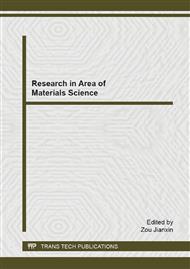p.392
p.397
p.402
p.407
p.413
p.417
p.422
p.429
p.435
The Changes of Thickness and Tearing Behavior of Tencel Fabrics Treated with Different Time by Plasma
Abstract:
Tencel fabrics were treated with low pressure plasma with air for different treatment time. The samples were tested their thickness and calculated each mean value of fabrics treated with different time. The result indicated that samples became thicker with the prolonged plasma treatment time. The samples were also divided into two groups and tore along warp and weft direction, respectively, to measure the influence of plasma treatment time on the tearing strength. The result of the measurement implied that the tearing strength of samples treated 1 minute by plasma decreased dramatically, when they were compared with the untreated ones. However, the decrease of the tearing strength became slight when the plasma treatment increased to 5, 10 and 20 minutes.
Info:
Periodical:
Pages:
413-416
Citation:
Online since:
April 2015
Authors:
Keywords:
Price:
Сopyright:
© 2015 Trans Tech Publications Ltd. All Rights Reserved
Share:
Citation:


